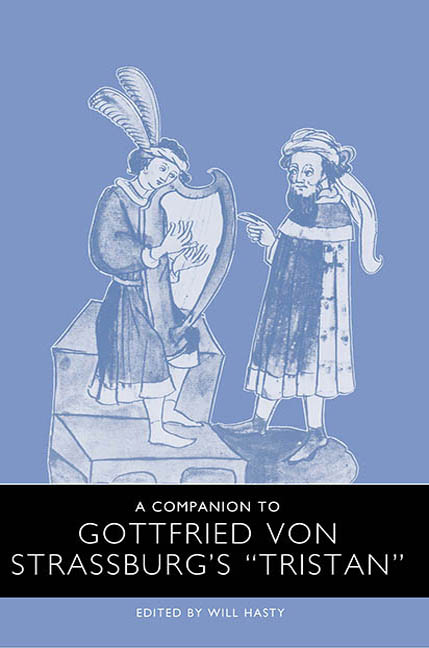Book contents
- Frontmatter
- Contents
- Acknowledgments
- Introduction: The Challenge of Gottfried's Tristan
- I Cultural and Social Contexts
- II Figures, Themes, Episodes
- III Gottfried's Narrative Art
- IV The Medieval and Modern Reception of Gottfried's Tristan
- The Medieval Reception of Gottfried's Tristan
- The Modern Reception of Gottfried's Tristan and the Medieval Legend of Tristan and Isolde
- Notes on the Contributors
- Index
The Modern Reception of Gottfried's Tristan and the Medieval Legend of Tristan and Isolde
from IV - The Medieval and Modern Reception of Gottfried's Tristan
Published online by Cambridge University Press: 28 April 2017
- Frontmatter
- Contents
- Acknowledgments
- Introduction: The Challenge of Gottfried's Tristan
- I Cultural and Social Contexts
- II Figures, Themes, Episodes
- III Gottfried's Narrative Art
- IV The Medieval and Modern Reception of Gottfried's Tristan
- The Medieval Reception of Gottfried's Tristan
- The Modern Reception of Gottfried's Tristan and the Medieval Legend of Tristan and Isolde
- Notes on the Contributors
- Index
Summary
Wer die Schönheit angeschaut mit Augen
ist dem Tode schon anheimgegeben.
August von PlatenThe origins of the tristan legend are still obscure today, but we know for sure that its transition from orality to literacy occurred in medieval France. Unfortunately, the first French Tristan romances by Béroul and Thomas have been transmitted only in fragments. Since Gottfried's romance was not completed by its author, it is the poem of a medieval German writer of relatively modest literary ability, Eilhart von Oberge, that ironically represents the first complete medieval version of the legend. Nevertheless, the number of surviving manuscripts tells us that Gottfried's romance, together with its continuations, was well known in German-speaking countries. More widespread in western Europe were large-scale prose versions, which in the late Middle Ages made the legend of Tristan and Isolde the most popular story in secular literature. From the end of the Middle Ages to the beginning of the revival of interest in the Middle Ages at the end of the late eighteenth century, the legend was never completely forgotten, even if it is unlikely that many were reading Gottfried's work during these centuries. If educated people knew anything about Tristan and Isolde, this would have been from one of the above-mentioned prose versions, many of which were printed in France, England, Spain, and the Italian- and German-speaking countries: the French Tristan en prose (eight printings from 1489 till 1586), Malory's book about Sir Tristrem (Morte Darthur, Book V; printings from 1485 till 1634), the Italian and Spanish prose versions produced from the fourteenth to the sixteenth century (Rusticciano da Pisa; Tristano Riccardiano, Tristano Veneto, Tavola Rotonda, I due Tristani; Tristán de Leonis, etc.), and the German prose version and Volksbuch (printings from 1484 till 1664).
The modern revival of the medieval legend is also based on versions such as that of Comte de la Vergue de Tressans (Extraits de romans de chevalerie, in Bibliothèque universelle des romans, 1775–89) and on new printings of the late medieval prose versions (the German prose version edited by Friedrich Heinrich von der Hagen in 1809, and an edition of Malory edited by Robert Southey in 1817).
- Type
- Chapter
- Information
- A Companion to Gottfried von Strassburg's Tristan , pp. 285 - 304Publisher: Boydell & BrewerPrint publication year: 2003



